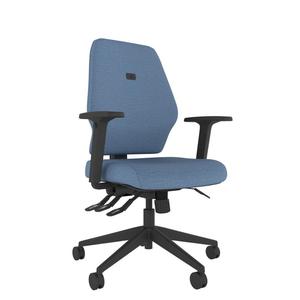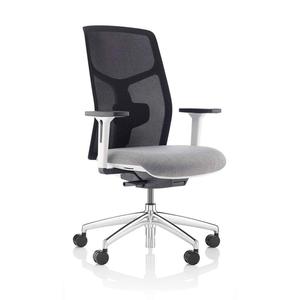Tips for Buying an Ergonomic Chair
No one type of office chair is necessarily the best, but there are some things that are very important to look for in a good ergonomic office chair. These things will allow the individual user to make the chair work well for his or her specific needs.
1. Do you sit still for most of the day?
It is not just about lumbar support, it should be about MOVEMENT! The best ergonomic chairs have movement. A movement that supports your body throughout the day, following your movements and protecting the curve of the spine and your posture. Whilst some people, for medical reasons, may not suit a chair with movement, the majority of people would benefit, whether or not they have an existing back problem. Buying an ergonomic chair should be about prevention, not just about relief.
2. Do you sit too low with your shoulders hunched up to use the keyboard?
Office chair seat height should be easily adjustable. A pneumatic adjustment lever is the easiest way to do this. . The user should have his or her feet flat on the floor, or a footrest, with the shoulders relaxed and the pelvic angle in an open position.
3. Is the seat pressing on the back of your legs?
The seat should have enough width and depth to support any user comfortably. The depth (from front to back of the seat) needs to be enough so that the user can sit with his or her back against the backrest of the ergonomic office chair while leaving approximately 1-2 inches between the back of the knees and the seat of the chair. The forward or backward tilt of the seat should be adjustable.
4. Is your lower back supported properly?
Lower back support in an ergonomic chair is very important. The lumbar spine has an inward curve, and sitting for long periods without support for this curve tends to lead to slouching (which flattens the natural curve) and strains the structures in the lower spine. An ergonomic chair should have a lumbar adjustment (both height and depth) so each user can get the proper fit to support the inward curve of the lower back. However, not everyone wants a pronounced lumbar support, and Shape can offer a collection of office chairs with different types of backrest, with pelvic support, 'hugger' backrests, or even no back support at all - see kneeling chairs.
5. Is your backrest adjustable?
A backrest should be adjustable in height and preferably in angle - although this is not always essential if the chair has a good movement in the mechanism. It should be able to support the natural curve of the spine, again with special attention paid to proper support of the lumbar region.
6. Are your armrests adjustable? Do they interfere with the desk top?
Office chair armrests should be adjustable. They should allow the user's arms to rest comfortably and shoulders to be relaxed. The elbows and lower arms should rest lightly, and the forearm should not be on the armrest while typing. It is also very important that armrests do not impede on the edge of the desk - most of our chairs are available with short, or retracting armrests.
7. Does your chair swivel round easily?
Any conventional style or ergonomic chair should easily rotate so the user can reach different areas of his or her desk without straining.
If you are unsure which product would best suit you please do not hesitate to contact us and we will be happy to advise. Many of our chairs are available on a trial basis to ensure suitability, so please ask about this service - Orthopedic chairs are by their nature very individual, and as such we feel that it is essential that the proper advice is provided.

